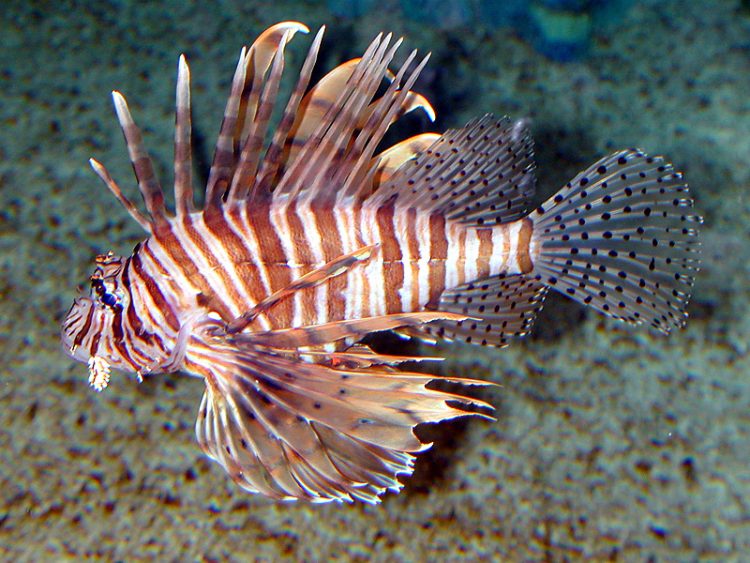Researchers Discover Hurricanes Helped Accelerate Spread of Lionfish

Lion Fish
Just when you thought hurricanes couldn't get any scarier, think again.
Their names roll of the tongue like a rogues' gallery: Floyd, Frances, Irene, Wilma and Andrew. But these aren't the names of notorious criminals; rather, they are just a few of the hurricanes since 1992 that have helped spread invasive marine species throughout the Florida Straits.
Researchers at Nova Southeastern University's (NSU) Oceanographic Center have discovered that storms don't only have a dramatic impact on land; they have an equally dramatic effect on ocean currents, which helps the spread of marine invasive species throughout a region. More specifically, NSU researchers looked at the distribution of lionfish in the Florida Straits.
“This is the first-ever study that shows hurricane-altered ocean currents are able not only to help, but actually accelerate the invasion of non-native marine species of any kind,” said Matthew Johnston, Ph.D., one of the research scientists at NSU's Oceanographic Center who conducted the study. “Lionfish are pretty sedentary, so this is like creating express lanes on a superhighway – otherwise, that's a pretty long swim for lionfish babies.”
The research, conducted by Johnston and NSU Oceanographic Center Professor Sam Purkis, Ph.D., focused on the explosion of lionfish populations in area waters. Their findings are being published in the journal Global Change Biology. Another NSU Oceanographic Center Professor, Richard Spieler, Ph.D., in the course of his research, was one of the first to see lionfish in Bahamian waters soon after their arrival.
Not to be too technical, Johnston said that the research focused on how large storms (i.e. hurricanes) affect the flow of water in the Florida Straits. Normally, the currents represent a potential barrier to the transport of lionfish eggs and larvae across the Florida Straits. The researchers found that as a hurricane passes, the flow of water shifts from a strong, northern flow to a strong, eastern flow.
It's these changes in flow direction and speed that likely carry lionfish larvae and eggs from Florida to the Bahamas and can explain how lionfish were able to cross the Gulf Stream so soon after their introduction to South Florida waters.
Johnston said that once they were established in the Bahamas, hurricanes allowed lionfish to spread quickly against the normal, northwestern direction of water flow in the area. In addition, the storms helped increase the spread of lionfish by approximately 45% and their population size by 15%.
“The study has broader implications in that global climate change may cause an increase in storm frequency and/or intensity, perhaps further accelerating the spread of marine invasives,” Johnston said. “Given that South Florida is a hotspot for marine invasive species, the transport of marine larvae from Florida to the Bahamas on hurricane-altered water flow may become commonplace for invasive and native species alike.”
Johnston indicated this research has two implications. First, we need to make a concerted effort to prevent marine introductions to begin with and second, we must implement vigorous, early-detection programs to remove these invasive species before they become a problem. Now the team wants to take this research concept and study similar situations in the South Pacific where typhoons are common.
You can find the complete paper on the effect hurricanes have on non-native species in the Florida Straits online at Global Change Biology.
About Nova Southeastern University (NSU): Located in beautiful Fort Lauderdale, Florida, NSU is a dynamic research institution dedicated to providing high-quality educational programs at the undergraduate, graduate and first-professional degree levels. An independent, not-for-profit institution with approximately 25,000 students, NSU has campuses in Fort Lauderdale, Fort Myers, Jacksonville, Miami, Miramar, Orlando, Palm Beach and Tampa, Florida as well as San Juan, Puerto Rico and online globally. For more than 50 years, NSU has been awarding degrees in a wide range of fields, while fostering groundbreaking research and an impactful commitment to community. Classified as a research university with “high research activity” by the Carnegie Foundation for the Advancement of Teaching, NSU is one of only 37 universities nationwide to also be awarded Carnegie's Community Engagement Classification. For more information, please visit www.nova.edu
About NSU's Oceanographic Center: The Oceanographic Center provides high-quality graduate education programs (i.e. master's, doctoral, certificate) in a broad range of marine science disciplines. Center researchers carry out innovative, basic and applied marine and research programs in coral reel biology, ecology, and geology; fish biology, ecology, and conservation; shark and billfish ecology; fisheries science; deep sea organismal biology and ecology; invertebrate and vertebrate genomics, genetics, molecular ecology, and evolution; microbiology; biodiversity; observation and modeling of large scale ocean circulation, coastal dynamics, and ocean atmosphere coupling; benthic habitat mapping; biodiversity; histology; and calcification. For more information, please visit http://www.nova.edu/ocean
Contact Information
Joe Donzelli
Associate Director, Public Affairs
jdonzelli@nova.edu
Phone: 954-262-2159
Media Contact
All latest news from the category: Ecology, The Environment and Conservation
This complex theme deals primarily with interactions between organisms and the environmental factors that impact them, but to a greater extent between individual inanimate environmental factors.
innovations-report offers informative reports and articles on topics such as climate protection, landscape conservation, ecological systems, wildlife and nature parks and ecosystem efficiency and balance.
Newest articles

Silicon Carbide Innovation Alliance to drive industrial-scale semiconductor work
Known for its ability to withstand extreme environments and high voltages, silicon carbide (SiC) is a semiconducting material made up of silicon and carbon atoms arranged into crystals that is…

New SPECT/CT technique shows impressive biomarker identification
…offers increased access for prostate cancer patients. A novel SPECT/CT acquisition method can accurately detect radiopharmaceutical biodistribution in a convenient manner for prostate cancer patients, opening the door for more…

How 3D printers can give robots a soft touch
Soft skin coverings and touch sensors have emerged as a promising feature for robots that are both safer and more intuitive for human interaction, but they are expensive and difficult…





















